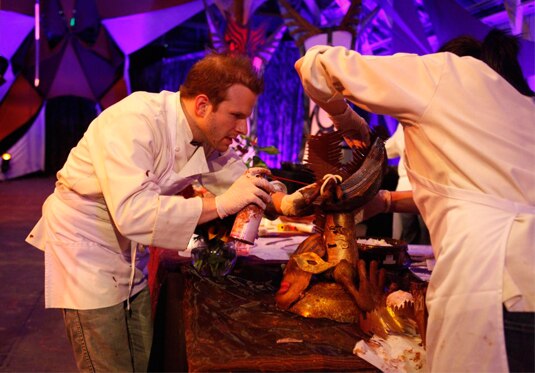Brulee, Flambe, and Mirliton Cakes
Eli Kirshtein tells a funny story about the first flambe.

So I have talked before about how there are some hyper-focused and specialized parts of the pastry world, and centerpieces might be one of the most concentrated disciplines. They are only in traditional restaurant settings on the rarest of occasions. Oh, and they are really hard to do. The chefs have to combine chocolate and sugar in different shapes, colors, and textures to make something unique and gorgeous, with many brownie points added for physical acrobatics that include really large and heavy items placed on top of tiny delicate pieces. They are often done in competition settings. It was really impressive to see the chefs make the pieces so well and so quickly.
There seems to be a little grey area on the difference between bakers and pastry chefs. So here’s the thing: there really isn’t a hard and true definition of either. For the most part you would associate a baker with doing baked goods. Think bread, cookies, muffins, cakes, etc. A pastry chef is a little more ambiguous. They typically focus on desserts, the last course of a meal. At times, reasonably often, they may find themselves tasked with other jobs in the kitchen, but there fundamental focus is on the last few stages of a meal. Now this is just a guideline. I wouldn’t want to offend a person who considers him/herself a baker or pastry chef, but this is more or less the difference between the two.
There was a question posed to me of what the specific definitions of two terms are. The first is Brulée. This term when translated from French literally means burned. In the pastry world, and culinary world on the whole it typically means when something has been aggressively browned. The two most common occurrences are when sugar is put on top of a custard and caramelized to a brown crunchy shell as in a Crème Brûlée, and when an onion is cut in half and browned to an almost black color and added to stocks and sauces for flavor and color, known as an Onion Brûlée. The second term is Flambé. This word when translated means flamed. It traditionally means when alcohol is added to a dish, heated, and lit on fire. The most common origin of flambéing dishes traces to 1895 when a 15-year-old assistant waiter named Henri Carpentier was working in a restaurant in Monte Carlo known as Café de Paris. He was preparing a dessert for the Prince of Wales, the soon to be crowned King Edward VII of The United Kingdom. He caught the pan he was preparing the dessert in on fire and it became ignited. This account is disputed, but it’s a fun little story to associate with it. Many people claim the flavor of flambéing is nominal and its all for show, others insist that it makes a dramatic difference. Either way it now makes appearances in many famous dishes in both savory and sweet, such as Steak Diane and Bananas Foster.
Something that caught my eye was the flaming dessert, or lack thereof, for the Sassy, Sexy, Sultry team. They called it a Mirliton Cake. Now, this one needs a little bit of explanation. In the savory world there is a vegetable called a Mirliton, also known as a chayote, it is like a mix of a squash and a pear. Conversely in the pastry world there is a real clandestine, old school dessert called a Mirliton. There are two variations of the pastry; the first is called a Mirliton de Pont-Audemer. It dates all the way back to around 1340 when it was created by the medieval French chef Guillaume Tirel, also known as Taillevent, who is known to have written the first French cookbook and also was the house chef of King Charles V. It is a tube-shaped pastry that resembles a flute like musical instrument known as a Mirliton. It is often garnished with praline paste and dipped in chocolate. This gradually evolved into a second variation known as a Mirliton de Rouen, which dates from around 1800. It is a puff pastry tart filled with frangipane, an almond flavored cream. It often times is garnished with apricots, apples, or sliced almonds. These are both very regional, esoteric pastries, so it is very surprising to see one pop up on the show.
Follow me on Twitter @elikirshtein



